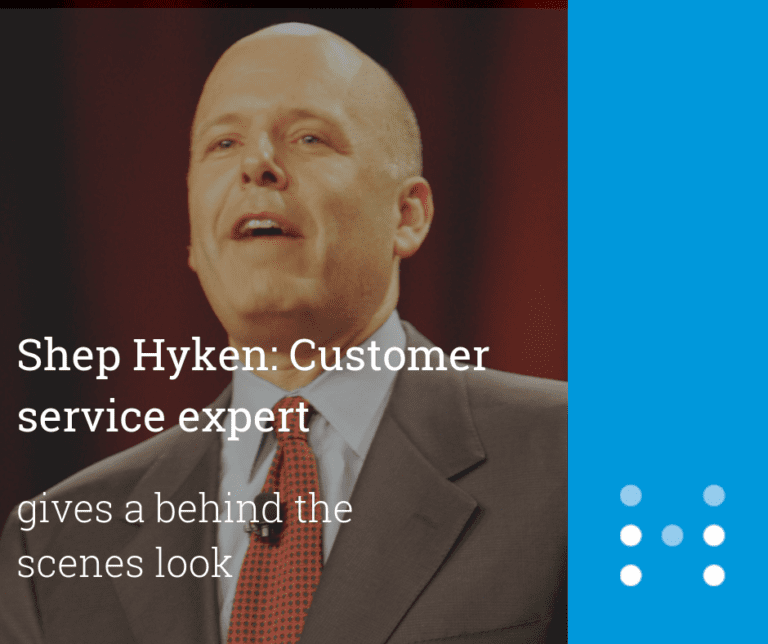At Humach, we’re obsessed with the customer experience. While this concept has been around for ages, it has just recently become the driving force for many successful enterprises.
That’s why we spoke with the world-renowned customer service and experience expert Shep Hyken. His presentations and speeches have had an immense impact on the customer experience sector, earning him a spot in the National Speakers Association Hall of Fame. He’s also a New York Times and Wall Street Journal bestselling author.
After just a few minutes, it was clear that Shep is not just passionate about the customer experience — he is truly an expert. If you are looking to build loyal customers and even loyal employees, Shep’s knowledge is definitely a key to success. Take a look at what he had to say.
What are some of the biggest changes in the types of customer experience, and the importance of customer experience since you began working in the field?
People are thinking about it and talking about it more than they used too.
By 2020, 80% of executives will be on board with creating a customer experience initiative that is even more important than almost any other marketing strategy that they can implement.
The concepts of customer service became blurred, where you weren’t sure about service or experience — whether they were the same or difference, well now, customer experience encompasses customer service, but it is all things related to interaction that a customer has with your product or service.
Customers are becoming smarter and smarter. Part of the reason is great companies are promising great customer service and experiences, they’re delivering on that promise and setting the bar higher for every other company. The point being this, customers no longer compare you to your direct competitor but to the best service they’ve ever had from anyone.
What does it take to unify a company around a customer experience initiative?
It has to be in the culture. It’s not a department or a division, or some group of people that handle customer support and experience. It’s part of the culture. From the CEO to the most recently hired , everybody understands what their role is when it comes to service and experience. And recognize that we’re going to train everybody to that role, that means that somebody that is in a support center is going to be trained completely different than somebody that’s in the accounting department or the warehouse of a company.
If the person in the warehouse says “I never see a customer, I don’t ever interact with a customer, I don’t understand why you’re putting me through customer service training. It’s because you don’t realize that what you do impacts the customer. If you don’t get that, we need to find another person.
If that person in the warehouse pulls a product off the shelf, puts it into the box the wrong way and it gets damaged in the process of the shipment, who’s fault is that? Well, ultimately you can blame it on the guy or gal in the warehouse. But, what happens is the customer doesn’t say it was one person, it was the entire company. The warehouse worker reflects and has this awesome responsibility that their actions do create an opinion that a customer has of the company they do business with.
It’s cultural, it’s that simple. It has to be ingrained in the company and it’s gotta be part of something they stand for.
With so many customer experience professionals being limited by IT roadmaps for putting in place new solutions, are there any things they could do in the mean time to immediately impact the customer experience in positive way.
Sometimes we put these great systems in place, they appear to be great and maybe there’s some benefit to making it better for the customer. But sometimes, it causes the employee to have an issue of some kind. You mentioned IT, we put software in place and we make it more complicated for the employee to take care of the customer. That just means the employee has to work harder, they’re working at a higher stress level. I’m not saying the old way was the right way, but when you’re going to implement new software, once you get past training and everybody gets it, the experience should be easier than the last time. If you’re going to make it easier for the customer, make it easier for the employee as well.
How do you feel about the relationship between speed and empathy when it comes to customer interactions? Is there any way for companies to incorporate both without sacrificing one?
I don’t think there’s a choice anymore, you’ve gotta be both. It’s that simple. There’s the old saying, “you can have it cheap, fast, or good quality — choose two out of three.” Well today you don’t get two out of three, you get three out of three and even more on top of that. It’s not a choice, you’ve gotta do both here, empathy and speed. They belong together. It’s part of the entire experience.
If a company is a little behind on implementing technology, is there anything they can do to play catch up or leapfrog their competition?
Well they shouldn’t have gotten there to begin with. Playing catch up is far harder to do than keeping up, let alone being a front-runner. I think what happens is with all the technology that’s out there today, and with so much to choose from the problem is you don’t know what’s going to be good and what’s not going to be good — what’s going to work and what’s not going to work.
As a result of that, people have this analysis paralysis, they don’t know what they should buy because they have been analyzing and looking at so many things. Whether this is going to be obsolete in 6 months, you know what, it probably is going to be obsolete in 6 months. But based on what you know today about that customer and the experience you want them to have, is this going to do what you want, and if so can you live with this for longer than 6 months and not worry about something better or a new version coming out.
You know what, if I buy a phone today — a year from now, there’s a new phone that’s faster, that’s bigger, that’s better. Same thing with computers. There is no shortage of new technology coming down the line. Don’t get caught up in bells and whistles. Get caught up on what the end results of the customer is going to be. And if it gives the customer what they want, then that’s the technology to go with. If it’s what they want today, chances are that’s what they’ll want 6 months from now.
Let me put this in another term, you asked in the beginning what’s changed in customer service. I could have said: Nothing has changed, from the standpoint of what a customer wants and expects. Let’s take a customer support situation. The customer calls in, they are confused and have a question or there’s a problem and they want a resolution. Basically they’re not in a happy spot. And when they are done interacting with the company they want to be in a happy place — they want everything resolved or their questions answered. That’s never changed, that’s been the same for decades, since the beginning of anything that was ever called customer service. What has changed is the path to getting us there. What we want to try to do is have the tools in place to get us there quickly and efficiently, that’s going to meet or exceed the customer’s expectations in that sense.
I can only emphasize this enough, more than anything — what does the customer want and how easily and quickly can we get them there. That ease factor is really important. If every-time the customer calls me I have to go through the entire story all over again, that’s not easy. There’s plenty of great sophisticated systems and even not-so-sophisticated systems, that allow you to put notes in a record, warm-transfers rather than cold-transfers if they have to go to somebody else. Plenty of good technology out there, and not super expensive, that gets the customer what they want.
What are some of the best ways you’ve found to create brand advocates out of customers in an increasingly digital age, and what do millennials and Gen Z’ers tend to expect when it comes to experiences?
They were brought up with technology that baby boomer didn’t have. I just saw a very interesting infographic that sums it all up. A millennial can reactively deal with three different modes of communication or three different screens. A Gen-Z can deal with 5, because they were brought up with 3 and added on. Millennial were brought up with 1 and they added on. It’s about capacity.
A younger generation is more adept to the technology than we are. Let’s talk about quicker and expectations. We’re talking about what the answer to a question, and as we talk about it a kid sitting at the table saying nothing, eventually says “I have the answer it’s right here on my phone.” They went straight to the phone for the answer, as we’re still talking about it and eventually would go to Google. That’s the difference, being raised with it. It’s part of their culture.



